
Europa and Titan
Europa
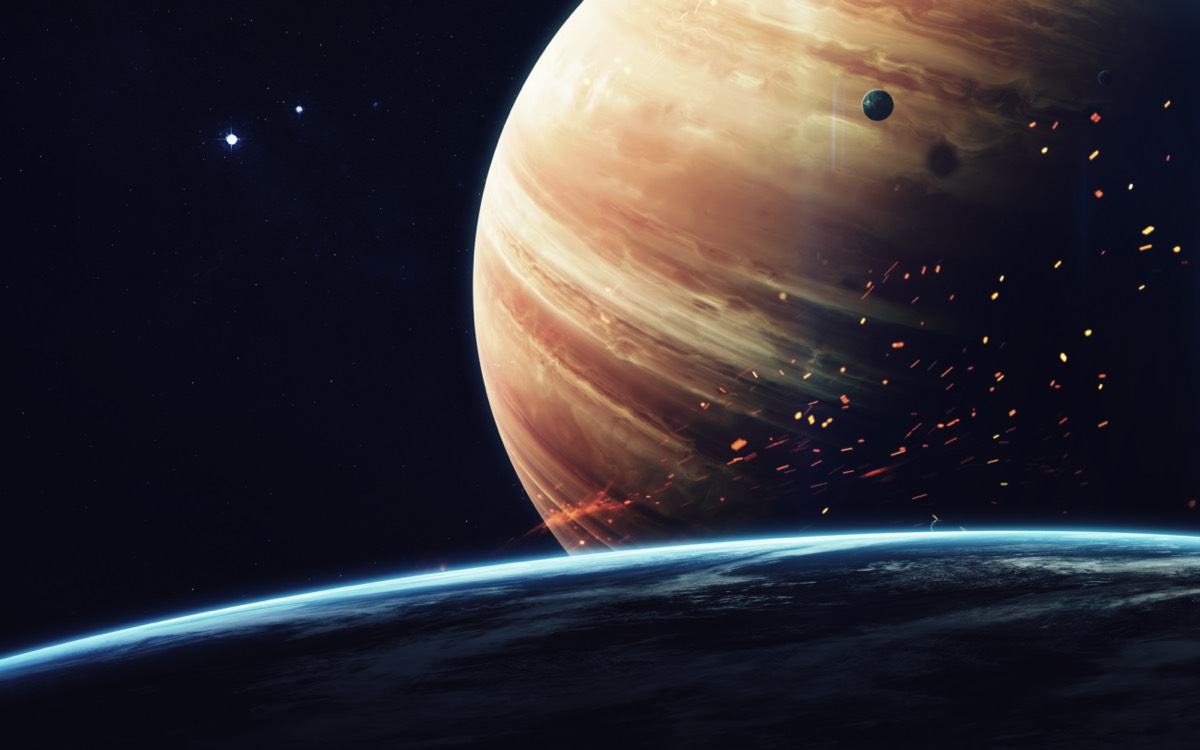
Europa
An ocean trapped under ice.
Europa is covered by a water sheet estimated to be a hundred kilometers (62 miles) thick, the surface layer being frozen ice, the rest probably in liquid form. It is one of the smoothest objects in the solar system with few craters on its surface.
Smooth as baby skin.
Europa's most prominent surface features, its lineae (lines), are a result of brightness contrast in images, between adjacent surface areas. There are no large mountains or deep ridges, and only small craters since the surface of Europa is relatively new: Between 20 and 200 million years old.
Lots of oxygen, but no air to breathe.
Europa's atmosphere practically consists of nothing but oxygen. This means two things: it's not breathable by human standards since Earth's atmosphere is mainly nitrogen and only 22% oxygen, and it's extremely thin. The oxygen is continuously produced from the ice surface, by way of radiolysis (radiation splits the water molecules into hydrogen and oxygen), but most of it escapes into space.
A possible harbor of life.
If the hypothesis of the largest part of the water sheet being in liquid form is confirmed, then the volume of water will be twice as much as Earth's oceans, and there could exist microbial life, in conditions similar to certain deep ocean areas where energy from hydrothermal vents provides organisms with energy, instead of the sun. As far we know, this is the most realistic probability for life in our solar system.
The Facts
Colonization
Europa as a target for human colonization has several benefits compared to other bodies in the outer Solar System, but is not without challenges.
Europa is thought to have a liquid water ocean underneath its icy exterior. Access to this liquid water ocean is a major difficulty, but the abundance of water on Europa is a benefit to any considerations for colonization. Not only can water provide for colonists' drinking needs, it also can be broken down to provide breathable oxygen. Oxygen is also believed to have accumulated from radiolysis of the ice on the surface that has been convected into the subsurface ocean and may prove sufficient for oxygen-using marine life.
The colonization of Europa presents numerous difficulties. One is the high level of radiation from Jupiter's radiation belt, which is about 10 times as strong as Earth's Van Allen radiation belts. Europa receives 5.4 Sv (540 rem) of radiation per day, which is approximately 1,800 times the average annual (yearly) dose of a human on earth at sea level. Humans exposed to this level of radiation for one day would have greater than 50% mortality rate within 30 days [4]. Consequently, a human would require significant radiation shielding to survive at or near the surface of Europa. Colonists on Europa would have to descend beneath the surface when Europa is not protected by Jupiter's magnetotail, and stay in subsurface habitats. This would allow colonists to use Europa's ice sheet to shield themselves from radiation.
Another problem is that the surface temperature of Europa normally rests at −170 °C (103 K; −274 °F). However, the fact that liquid water is believed to exist below Europa's icy surface, along with the likelihood that colonists would spend much of their time under the ice sheet in order to shield themselves from radiation, may somewhat mitigate the problems associated with low surface temperatures. The low gravity of Europa may also present challenges to colonization efforts.
An ocean trapped under ice.
Europa is covered by a water sheet estimated to be a hundred kilometers (62 miles) thick, the surface layer being frozen ice, the rest probably in liquid form. It is one of the smoothest objects in the solar system with few craters on its surface.
Smooth as baby skin.
Europa's most prominent surface features, its lineae (lines), are a result of brightness contrast in images, between adjacent surface areas. There are no large mountains or deep ridges, and only small craters since the surface of Europa is relatively new: Between 20 and 200 million years old.
Lots of oxygen, but no air to breathe.
Europa's atmosphere practically consists of nothing but oxygen. This means two things: it's not breathable by human standards since Earth's atmosphere is mainly nitrogen and only 22% oxygen, and it's extremely thin. The oxygen is continuously produced from the ice surface, by way of radiolysis (radiation splits the water molecules into hydrogen and oxygen), but most of it escapes into space.
A possible harbor of life.
If the hypothesis of the largest part of the water sheet being in liquid form is confirmed, then the volume of water will be twice as much as Earth's oceans, and there could exist microbial life, in conditions similar to certain deep ocean areas where energy from hydrothermal vents provides organisms with energy, instead of the sun. As far we know, this is the most realistic probability for life in our solar system.
The Facts
- Year discovered: 1610
- Discovered by: Galileo Galilei
- Position among Jupiter's moons: 6th satellite from the planet
- Size among Galilean moons: Smallest
- Average distance to Jupiter: 670,900 km, 416,877 miles
- Rotation: synchronous with Jupiter (9hr 50m 30s)
- Orbital period: 3days 13hr 13m 26.4s (3.551181 Earth days)
- Orbital Inclination to Jupiter's equator: 0.470 degrees
- Eccentricity: 0.009
- Diameter (equatorial): 3,138 km, 1,950 miles
- Mass: 4.80×1022 kg, 10.5821x1022 lbs
- Mean Density: 3,010 kg/m3, 187.908 lbs/ft3
- Gravity: 0.134g
- Escape Velocity: 2.025 km/s, 1.258 miles/s
- Surface temperature (average): -171C, -276F, 102K
- Surface pressure: 1 μPa, 10-11 bars, 9.8x10-12 atm
- Atmospheric composition: Almost entirely molecular oxygen (O2)
- Albedo: 0.67 +/- 0.03
Colonization
Europa as a target for human colonization has several benefits compared to other bodies in the outer Solar System, but is not without challenges.
Europa is thought to have a liquid water ocean underneath its icy exterior. Access to this liquid water ocean is a major difficulty, but the abundance of water on Europa is a benefit to any considerations for colonization. Not only can water provide for colonists' drinking needs, it also can be broken down to provide breathable oxygen. Oxygen is also believed to have accumulated from radiolysis of the ice on the surface that has been convected into the subsurface ocean and may prove sufficient for oxygen-using marine life.
The colonization of Europa presents numerous difficulties. One is the high level of radiation from Jupiter's radiation belt, which is about 10 times as strong as Earth's Van Allen radiation belts. Europa receives 5.4 Sv (540 rem) of radiation per day, which is approximately 1,800 times the average annual (yearly) dose of a human on earth at sea level. Humans exposed to this level of radiation for one day would have greater than 50% mortality rate within 30 days [4]. Consequently, a human would require significant radiation shielding to survive at or near the surface of Europa. Colonists on Europa would have to descend beneath the surface when Europa is not protected by Jupiter's magnetotail, and stay in subsurface habitats. This would allow colonists to use Europa's ice sheet to shield themselves from radiation.
Another problem is that the surface temperature of Europa normally rests at −170 °C (103 K; −274 °F). However, the fact that liquid water is believed to exist below Europa's icy surface, along with the likelihood that colonists would spend much of their time under the ice sheet in order to shield themselves from radiation, may somewhat mitigate the problems associated with low surface temperatures. The low gravity of Europa may also present challenges to colonization efforts.
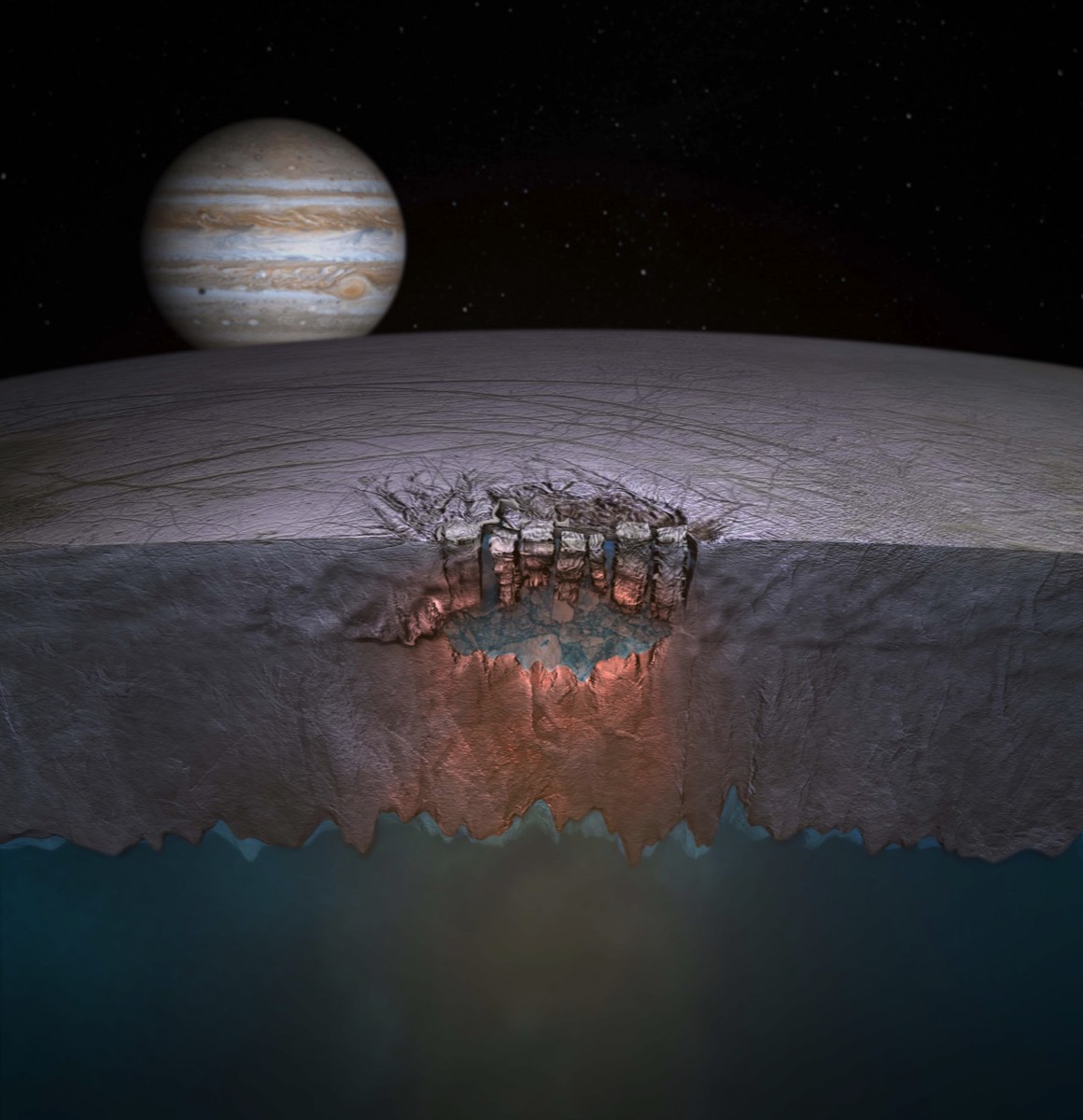
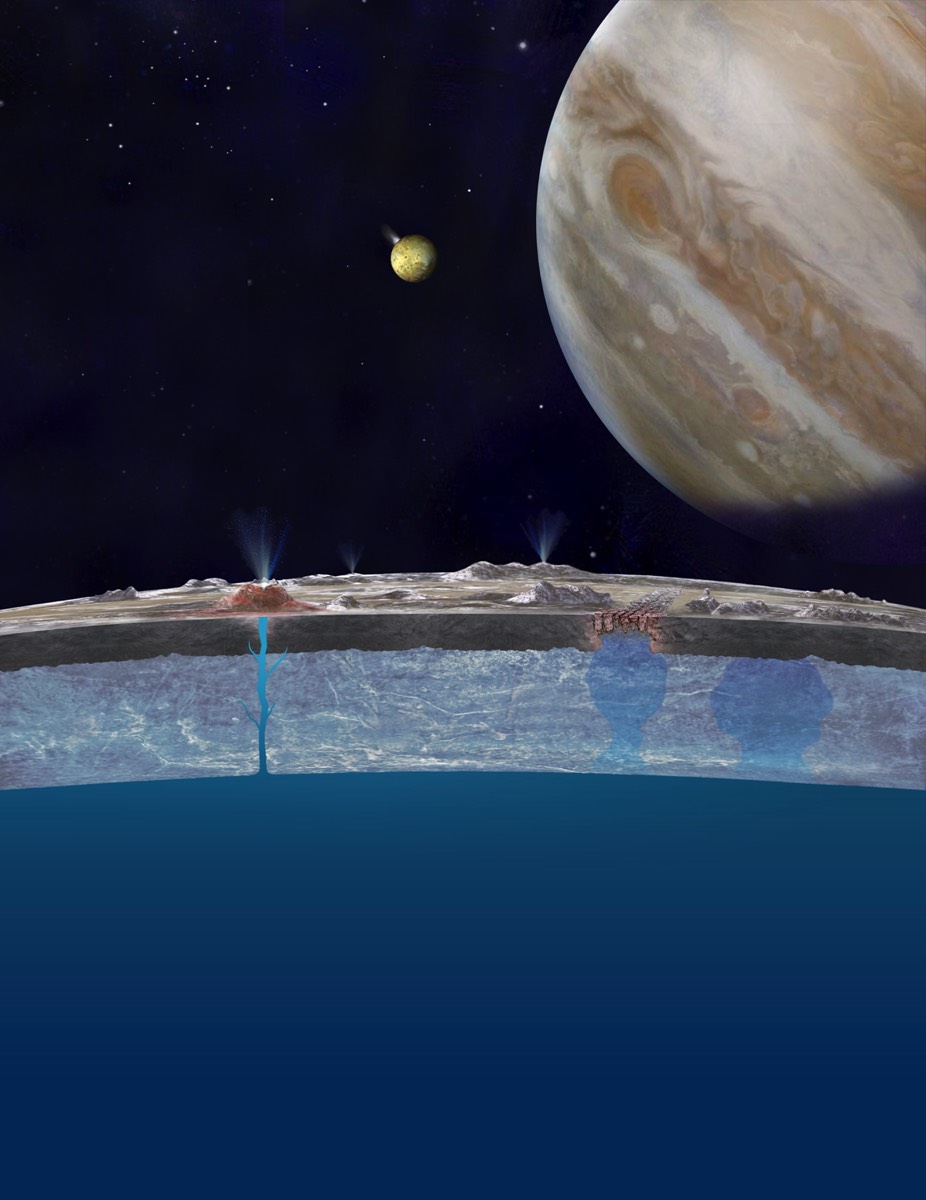
Enceladus
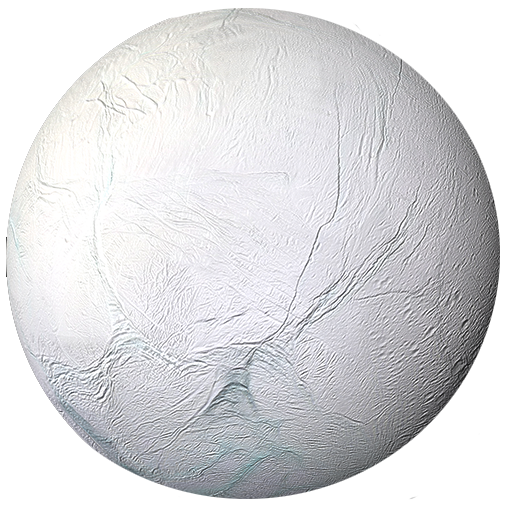
Enceladus
Enceladus is, to many, just an icy snowball floating around in space. But it's just become a lot more important: it's perhaps the greatest hope for life in our own solar system.
The small moon of Saturn, which has a 502km diameter, has been revealed to have hydrothermal processes going on underneath its crust. That, in turn, means that it may have all the requirements for life – and that microbial life might be found there. Enceladus is mostly covered by fresh, clean ice, making it one of the most reflective bodies of the solar system. Consequently, its surface temperature at noon only reaches −198 °C
Enceladus is, to many, just an icy snowball floating around in space. But it's just become a lot more important: it's perhaps the greatest hope for life in our own solar system.
The small moon of Saturn, which has a 502km diameter, has been revealed to have hydrothermal processes going on underneath its crust. That, in turn, means that it may have all the requirements for life – and that microbial life might be found there. Enceladus is mostly covered by fresh, clean ice, making it one of the most reflective bodies of the solar system. Consequently, its surface temperature at noon only reaches −198 °C
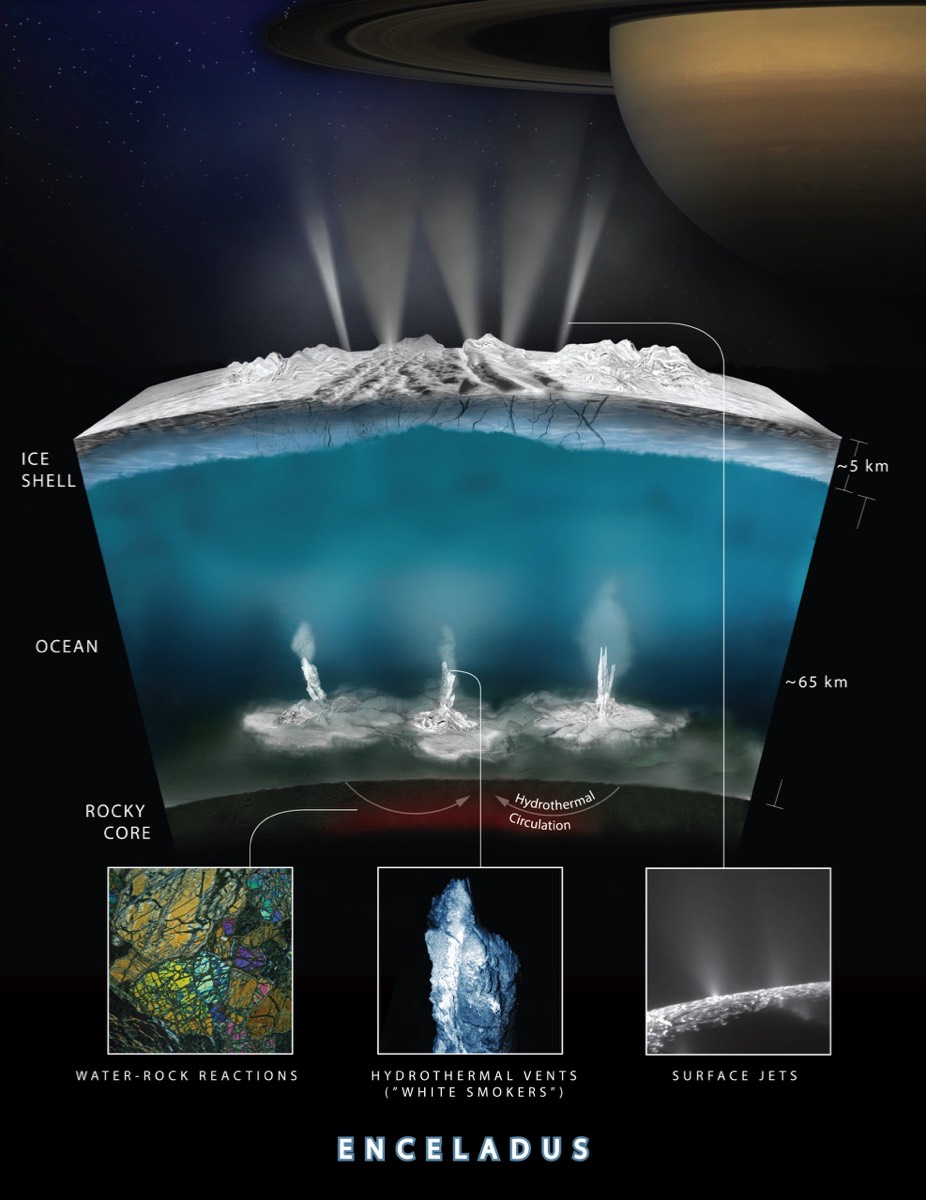
Titan
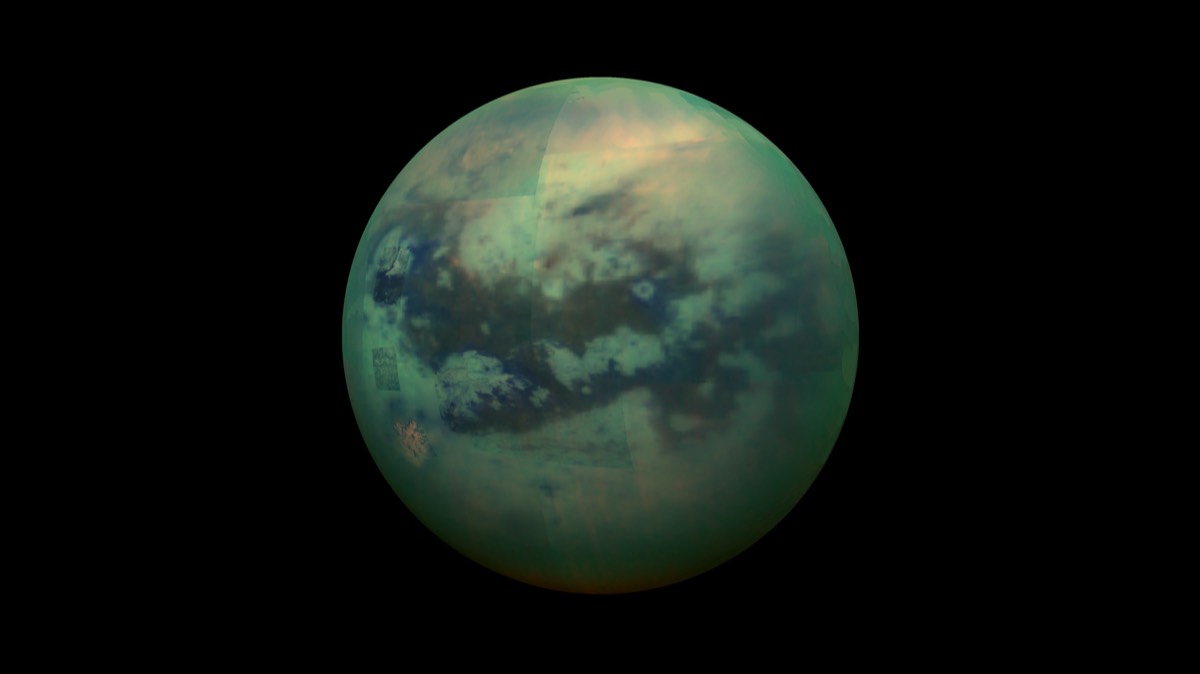
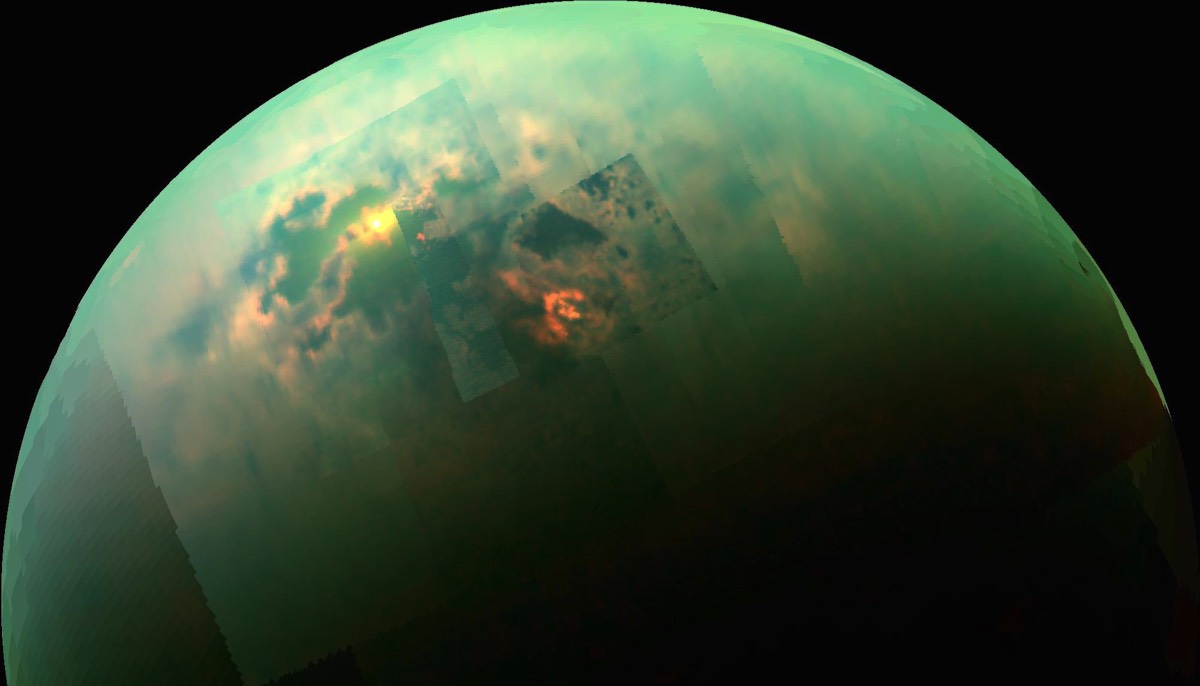
Titan
Titan is bigger than the planet Mercury, making it the largest of the more than 60 known moons orbiting Saturn. In certain ways, Titan is reminiscent of Earth; for example, rivers, lakes and oceans cover Titan’s surface, though they are made of methane and ethane instead of water. Titan has no water, but some scientists wonder if life based on methane might live on Titan. For protection from radiation, Titan has a nitrogen atmosphere 50 percent thicker than Earth’s. Saturn’s magnetosphere also provides shelter. On the surface, vast quantities of hydrocarbons in solid and liquid form lie ready to be used for energy. Although the atmosphere lacks oxygen, water ice just below the surface could be used to provide oxygen for breathing and to combust hydrocarbons as fuel. It’s cold on Titan, at -180°C (-291°F), but thanks to its thick atmosphere, residents wouldn’t need pressure suits—just warm clothing and respirators.
Titan's rotation period of about 16 days is synchronous to Saturn (meaning the same side always faces Saturn). It is the only moon in the Solar System known to have clouds and a thick, planet-like atmosphere.
You could fly in its sky
Titan’s thick atmosphere, low gravity (less than our Moon) and reasonable surface pressure (50% of Earth’s) mean that, by flapping a pair of wings strapped to your arms, you could fly in its skies with no more effort than walking.
It’s the only other world with liquid
Aside from Earth, Titan is the only world we know of that has liquids on its surface. These are in the form of lakes and rivers composed of liquid hydrocarbons including Ontario Lacus, a lake 240 kilometres (150 miles) long in Titan’s southern hemisphere.
It has a climate system like Earth
The liquids on Titan undergo a similar cycle to water here on Earth. Liquid methane evaporates from the surface, forming extremely thick clouds in the skies, before eventually raining down and replenishing the lakes and rivers on the ground.
Distance from Saturn 1 221 870 km
Distance from Sun 1 427 000 000 km (9.54 AU)
Diameter (atmosphere) 5550 km
Diameter (surface) 5150 km
Mass 1/45 that of Earth
Average density 1.881 times liquid water
Surface temperature 94K (-180 degrees C)
Atmospheric pressure at surface 1500 mbar (1.5 times Earth's)
Atmospheric composition Nitrogen, methane, traces of ammonia, argon, ethane
Orbital period (Titanic day) 15.95 Earth days
Titan is bigger than the planet Mercury, making it the largest of the more than 60 known moons orbiting Saturn. In certain ways, Titan is reminiscent of Earth; for example, rivers, lakes and oceans cover Titan’s surface, though they are made of methane and ethane instead of water. Titan has no water, but some scientists wonder if life based on methane might live on Titan. For protection from radiation, Titan has a nitrogen atmosphere 50 percent thicker than Earth’s. Saturn’s magnetosphere also provides shelter. On the surface, vast quantities of hydrocarbons in solid and liquid form lie ready to be used for energy. Although the atmosphere lacks oxygen, water ice just below the surface could be used to provide oxygen for breathing and to combust hydrocarbons as fuel. It’s cold on Titan, at -180°C (-291°F), but thanks to its thick atmosphere, residents wouldn’t need pressure suits—just warm clothing and respirators.
Titan's rotation period of about 16 days is synchronous to Saturn (meaning the same side always faces Saturn). It is the only moon in the Solar System known to have clouds and a thick, planet-like atmosphere.
You could fly in its sky
Titan’s thick atmosphere, low gravity (less than our Moon) and reasonable surface pressure (50% of Earth’s) mean that, by flapping a pair of wings strapped to your arms, you could fly in its skies with no more effort than walking.
It’s the only other world with liquid
Aside from Earth, Titan is the only world we know of that has liquids on its surface. These are in the form of lakes and rivers composed of liquid hydrocarbons including Ontario Lacus, a lake 240 kilometres (150 miles) long in Titan’s southern hemisphere.
It has a climate system like Earth
The liquids on Titan undergo a similar cycle to water here on Earth. Liquid methane evaporates from the surface, forming extremely thick clouds in the skies, before eventually raining down and replenishing the lakes and rivers on the ground.
Distance from Saturn 1 221 870 km
Distance from Sun 1 427 000 000 km (9.54 AU)
Diameter (atmosphere) 5550 km
Diameter (surface) 5150 km
Mass 1/45 that of Earth
Average density 1.881 times liquid water
Surface temperature 94K (-180 degrees C)
Atmospheric pressure at surface 1500 mbar (1.5 times Earth's)
Atmospheric composition Nitrogen, methane, traces of ammonia, argon, ethane
Orbital period (Titanic day) 15.95 Earth days
